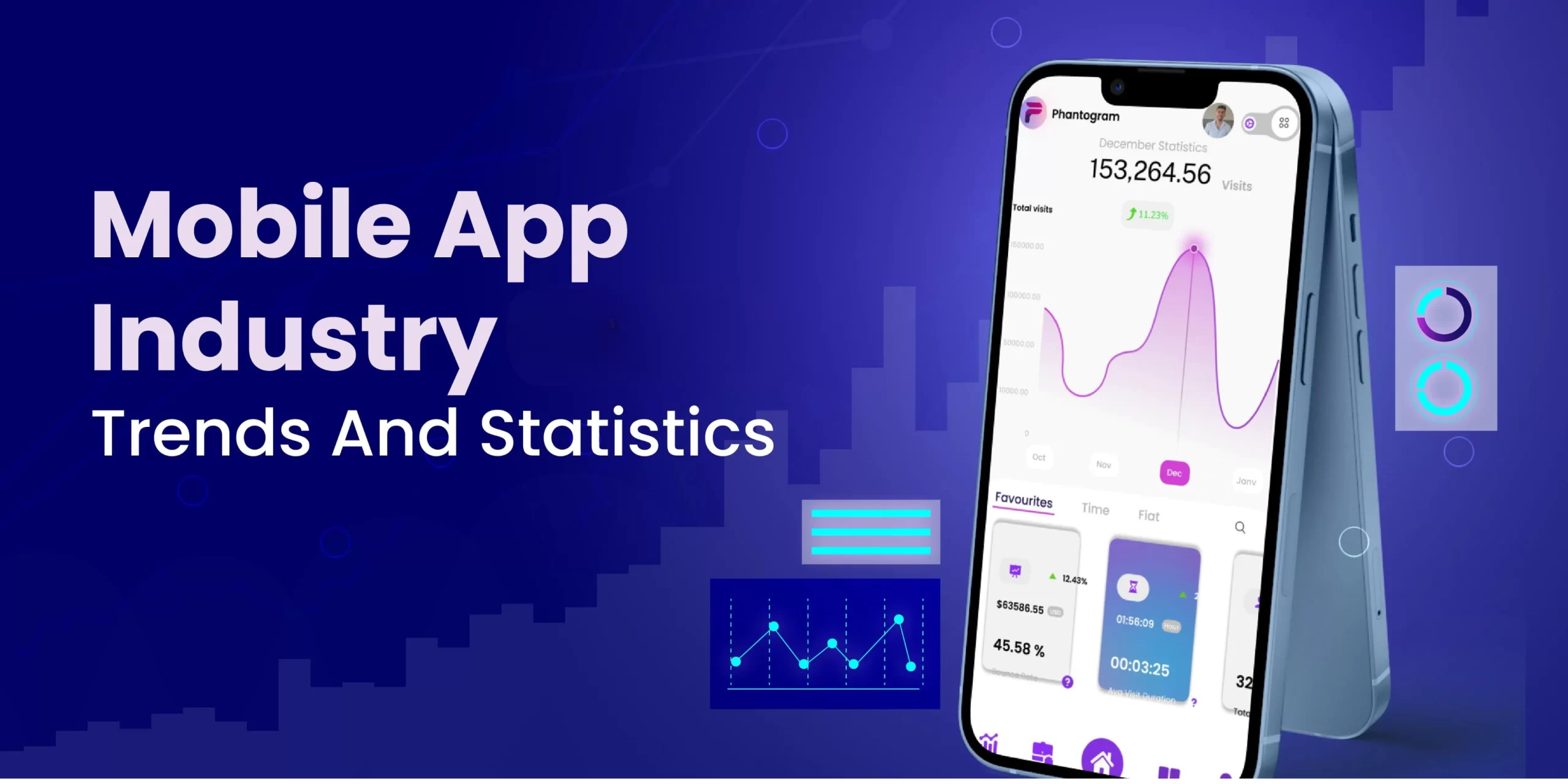The mobile app market has advanced significantly over time and is increasingly important in our daily lives. As we are in 2025, the mobile app industry continues to evolve rapidly, and it’s essential to stay updated on the latest trends and statistics. The global epidemic in recent years has increased the uptake of mobile applications, with people increasingly depending on them for work, leisure, and communication. As a result, the mobile app market is anticipated to expand even more in the upcoming years.
This blog will explore the most recent trends and data in the mobile app industry, which are expected to have an impact on the sector’s future. We’ll look at the well-liked app categories, financial structures, user behavior, and much more. This blog will offer insightful information on what the mobile app business may expect in 2025 and beyond.
Mobile App Industry: The Most Important Statistics
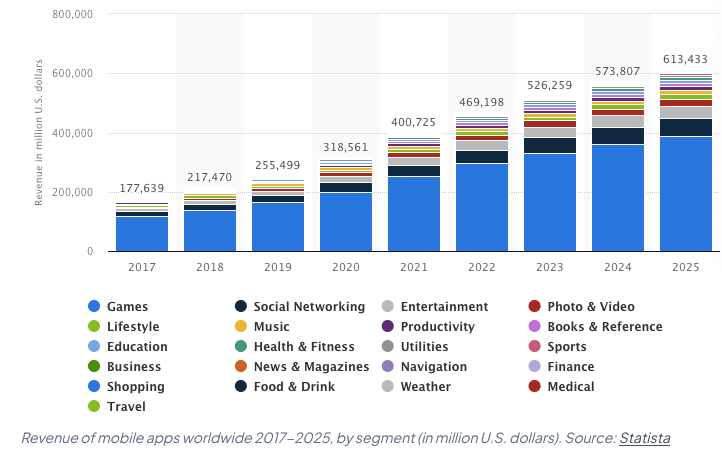
- By 2025, revenue from mobile apps is expected to increase across most segments and reach a total of around $613 billion.
- In 2023, mobile apps are expected to generate revenue exceeding $935 billion.
- The combined number of mobile apps on the Google Play Store and Apple App Store exceeds 5.7 million.
- The Apple App Store alone has a library of more than 2.2 million mobile applications.
- The Google Play and Apple App Store generated a combined revenue of $111 billion in 2021.
- A typical smartphone user accesses around 9-10 apps daily and 30 apps monthly.
- On average, an individual in the United States has about 80 apps installed on their smartphone.
- Mobile applications account for 85% of the total time spent on smartphones by users.
- In 2020, global app downloads reached a staggering 299 billion.
- With a market share of 85%, Android is the most widely used mobile operating system globally, with over three billion active users and a total of 108 billion downloads in 2020.
- The projected size of the global e-learning market is set to reach $650 billion by 2025, with a Compound Annual Growth Rate (CAGR) of 21% expected between 2021 and 2027.

Mobile App Economy Overview
According to a report by App Annie and Statista, between 2019 and 2020, there was a daily average of over 250 million app downloads, which amounts to more than 91 billion downloads annually.
Experts predicted that this number would continue to grow, and by 2025, it may reach as high as 500 million daily downloads, which would translate to 184 billion app downloads at the end of that year – twice the number recorded in 2020.
According to a report by Business of Apps, an interesting fact is that 98% of the revenue of Google Play comes from free apps. Although they do not require any payment to be downloaded, free apps serve as a marketing tool and can generate revenue through advertising. For instance, McDonald’s frequently creates gaming apps aimed at children to promote their brand. Therefore, free apps and advertisements are surprisingly useful for generating revenue.
As of 2022, the global consumer expenditure on apps has reached $129 billion. This is a massive sum, but it represents a slight decrease from the previous year when consumers spent approximately $133 billion on apps. In other words, there has been a 3% reduction in consumer spending on apps in just one year.
Global App Revenue 2016-2022
| Year | Total App Revenue (in billions USD) | iOS App Revenue | Google Play App Revenue |
| 2016 | $43.50 | $28.60 | $15 |
| 2017 | $58.10 | $38.50 | $21.20 |
| 2018 | $71.30 | $46.60 | $24.80 |
| 2019 | $89 | $58.40 | $30.60 |
| 2020 | $111 | $72.30 | $38.60 |
| 2021 | $133 | $85.10 | $47.90 |
| 2022 | $129 | $86.80 | $42.3 |
Business of Apps reports that mobile app consumers are expected to spend an impressive amount of $34.1 billion in app stores in Q1 2023, setting a new record for the highest quarterly spending. Furthermore, estimates suggest that consumer spending on apps will continue to increase, potentially surpassing $270 billion by 2025.
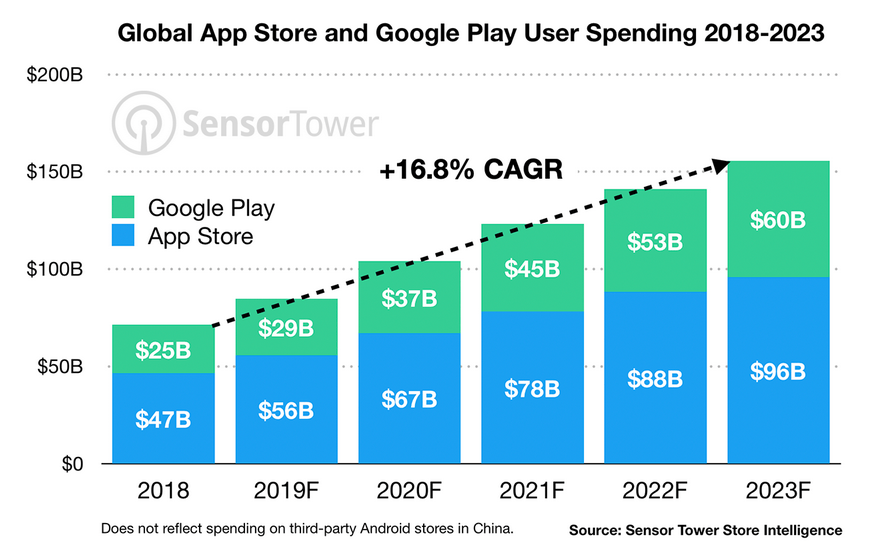
Sensor Tower Store Intelligence data suggest that there will be a surge in global user spending on mobile apps on both Apple’s App Store and Google Play in the coming years. By 2023, the estimated spending is $156 billion, marking a significant growth of 120 percent from 2018, with a compound annual growth rate (CAGR) of 16.8 percent over the next five years.
The projections also suggest that Apple’s platform will see revenue climb to $96 billion by 2023, an impressive increase of 104 percent from 2018’s total of $47 billion at a CAGR of 15.6 percent. While Google Play is expected to reach $60 billion in worldwide spending, representing a growth of 140 percent from 2018 at a CAGR of 19 percent, this will still be significantly less than Apple’s platform, which is projected to capture almost 62 percent of all revenue generated by the two stores.
The Latest Mobile App User Stats: 2023 Update
As the mobile app industry continues to profit from its creations, it’s important to acknowledge its success with its dependence on user downloads. Nowadays, mobile app users are a significant demographic.
CleverTap reports that mobile applications have greater engagement rates than mobile-optimized websites or desktop web browsing and conversion rates up to three times higher, ranging from 100% to 300%. While it is advantageous to have a website that is optimized for mobile devices, current statistics demonstrate that mobile apps outperform even the most effectively optimized websites in terms of user engagement and conversion rates. This considerable difference in conversion rates highlights the fact that creating a valuable app can result in significant long-term benefits.
The mobile app industry’s success relies on app downloads, which are ubiquitous, and the research shows the following data:
- Users engage with 30 apps per month, which equates to around two-thirds or more of the apps installed on the average consumer’s phone.
- Users use at least 9-10 apps per day, leading to the 30:10 rule.
- 51% of smartphone users check their apps 1-10 times per day. Another 25% check 11-20 times, 16% check 21-50 times, and 7% check more than 51 times every day.
- 85% of smartphone usage time is spent on apps. However, time is not equally distributed across all apps. Facebook accounts for 13% of US app usage, followed by Google at 12%. Google, Facebook, Amazon, and Apple make up over 30% of total app usage time.
Smartphone Users Statistics
As per the data provided by PewResearch, the typical smartphone user in the United States:
- Is predominantly male.
- Among the total population of smartphone owners, 80% are males, and 75% are females falling within the age range of 18 to 29 years old.
- The age group of 18 to 29 years old has the highest percentage of smartphone users, standing at 94%.
- The subsequent age group of 30 to 49-year-olds holds the second-highest percentage of smartphone users, with 89%.
- The proportion of smartphone users drops further among the age groups of 50 to 64-year-olds (73%) and 65 years or above (46%).
The table below presents an estimation of the growth of smartphone usage since 2016:
| Year | Number of Smartphone Users | Growth Over the Previous Year | Percentage Growth Over Previous Year |
| 2016 | 3.668 billion | – | – |
| 2017 | 4.435 billion | + 767 million | + 20.91% |
| 2018 | 5.095 billion | + 660 million | + 14.88% |
| 2019 | 5.623 billion | + 528 million | + 10.36% |
| 2020 | 5.924 billion | + 301 million | + 5.35% |
| 2021 | 6.259 billion | + 335 million | + 5.65% |
| 2022 | 6.567 billion | + 308 million | + 4.92% |
- Checks phone:
On average, Americans check their phone every 10-12 minutes, at least 96 times a day. However, statistics suggest that 66% of Americans check their phones up to 160 times a day.
- Time spent:
Americans typically spend a minimum of 5 hours on their phones daily, with nearly half the population spending between 5-6 hours and 22% spending 3-4 hours daily. Less than 5% of Americans spend less than an hour on their phones each day.
- App downloads:
A significant majority of smartphone users, accounting for 62%, would not download an app to complete a transaction. Of the remaining 38%, half would uninstall the app once their purchase is completed.
- Desktop/Mobile:
Americans still prefer desktops over mobile devices by 1.87%, spending an average of 3 hours 34 minutes on desktops and 3 hours 30 minutes on mobile devices, despite mobile devices being more popular worldwide.
OS Market Share
According to a report by IDC and StatCounter, the significance of OS market share lies in its ability to aid in the assessment of the favored platform for mobile applications. Understanding the market share of operating systems can provide valuable insight into which platforms are more commonly used, which will help in making informed decisions about which systems to prioritize when creating/investing in mobile applications.
As of January 2023,
- Android holds a 71.63% market share in the operating system (OS) market.
- iOS has a 27.68% market share in the OS market.
- Samsung’s market share in the OS market is 0.35%.
- KaiOS holds a 0.11% market share in the OS market.
- Windows has a 0.02% market share in the OS market.
- Nokia Unknown has a 0.01% market share in the OS market.
- Linux holds a 0.01% market share in the OS market.
In the US market, iOS leads with a market share of 55.85%, while Android claims a market share of 41.89%.
Trends And Projections In The Mobile App Industry

In 2022, the worldwide market for mobile applications was valued at USD 206.85 billion, with projections indicating a compound annual growth rate (CAGR) of 13.8% between 2023 and 2030. As we move forward, this sector is predicted to continue expanding at a significant pace.
Mobile app usage has been rising for several years, with no signs of slowing down. Below are some key facts and projections regarding trends in the mobile app industry:
- The mobile app industry is expected to generate revenue of $201 billion by the end of 2023.
- Mobile app revenue is experiencing impressive growth, with a CAGR of 19.5%. By 2025, consumer app spending may exceed $270 billion.
- Global installs of shopping apps rose by 10% between 2020 and 2021. Usage of these apps has grown even more significantly, at a rate of 30% year-over-year, indicating an increased preference for online shopping.
- TikTok emerged as the most downloaded app in 2022, with 104 million downloads in February alone. This represents a 46% increase from January 2021. Globally, TikTok amassed over 2 billion downloads in 2021 alone.
- From 2016 to 2021, yearly global app downloads have increased by 63.5%, from 140.68 billion to 230 billion downloads yearly.
- Business app downloads experienced a substantial increase of 102% in 2020, driven by the COVID-19 pandemic’s effects on remote work. In March 2020, business app downloads spiked by 225%.
User Retention Statistics In Mobile App Industry
Here are some insights on user trends and preferences that affect retention rates for mobile apps:
- App size plays a crucial role in user retention, with 50.6% of users uninstalling apps that take up too much memory on their phones.
- The churn rate of app users after three months is 71%, indicating that almost three-fourths of app users worldwide stop engaging with or uninstall an app within three months of downloading it.
- App crashes or other major errors lead to a 62% uninstall rate, which negatively affects retention and leads to negative reviews.
- Slow loading or downloading times are a significant factor in app abandonment, with 25% of users abandoning apps due to long loading times.
- E-commerce & Retail apps have the highest retention rate after 30 days, at 39%, as most users find these apps useful over a long period.
- Conversely, Social Networking apps have the lowest retention rate after 30 days, which may be surprising given the popularity of major social media sites. However, many smaller social media apps see high churn rates.
- Travel & Lifestyle apps have the highest retention rate after 90 days, with 23% of users still engaged. On the other hand, Social Networking apps have the lowest retention rate, with only 16% of users sticking around after 90 days.
- Almost half (47%) of apps require more testing before release. Many apps are not adequately prepared to meet user demands, whether for bugs or security issues. Shockingly, 75% of mobile applications fail basic security tests.
- Despite the benefits of mobile app marketing, only 54% of marketers use apps to reach their customers. This is surprising because half of the users discover new products and companies through mobile apps.
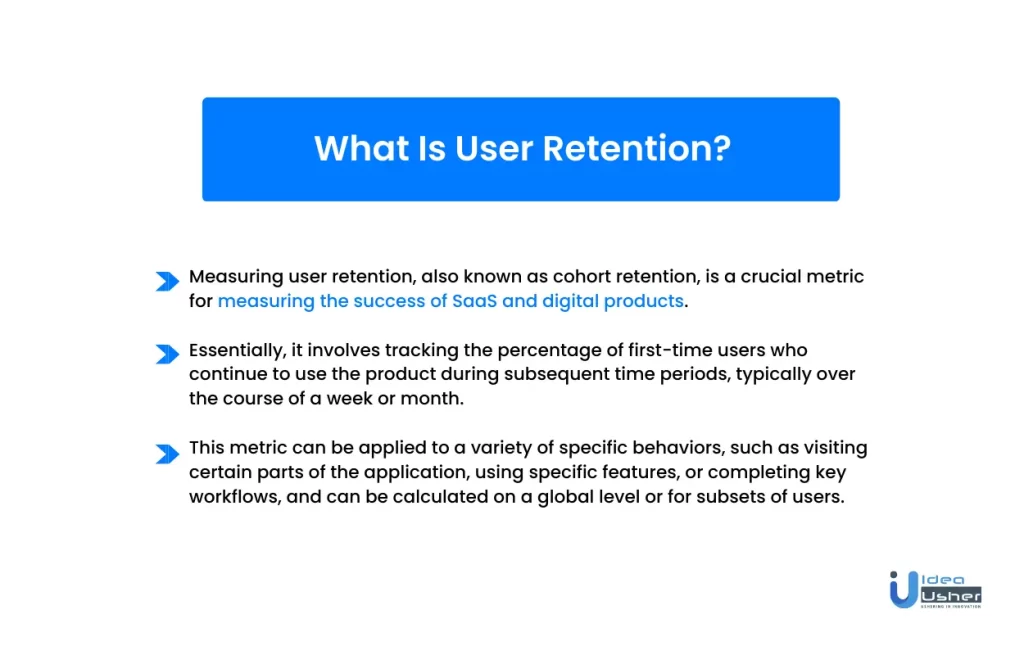
According to a report by Business of Apps,
- After conducting global research, it was found that the average retention rate across 31 mobile app categories was 25.3% on the first day but declined sharply to 5.7% by Day 30.
- On iOS devices, the average retention rate on Day 1 was 25.65%, which fell to 4.13% on Day 30. Similarly, on Android devices, the average retention rate on Day 1 was 23.01%, which decreased to 2.59% on Day 30. A good DAU/MAU ratio is around 20%, while anything above 25% is considered exceptional.
- It was also discovered that the average app loses 77% of its daily active users (DAUs) within the first three days after installation. Furthermore, the average Month 1+ churn rate was found to be 55%, while the Month 3+ churn rate was 68%.
- Effective implementation of in-app messages has been proven to boost retention by 30%. Additionally, owned media (push notifications, email, SMS) had Day 30 retention rates that were 30% higher in 2021 compared to user acquisition campaigns.
- Finally, the research showed that app users who engage with an app at least once a week are 90% more likely to become long-term users.
1. Retention Rate Of Different Types Of Mobile Apps:
The following table shows the retention rates for various types of mobile apps over a period of 30, 60, and 90 days:
| Type of Mobile App | 30-Day Retention Rate | 60-Day Retention Rate | 90-Day Retention Rate |
| Media & Entertainment | 37% | 27% | 22% |
| E-commerce & Retail | 39% | 27% | 22% |
| Travel & Lifestyle | 38% | 28% | 23% |
| Business & Technology | 34% | 23% | 17% |
| Social Networking | 30% | 20% | 16% |
Statistics For App Types
- Communication apps are the most frequently used type of app, with 50% of app users mainly using them for messaging and social media. Social media apps alone are the most frequently used type of app for 40% of smartphone owners, while messaging apps are the most frequently used for 10% of them.
- Gaming apps generate the most revenue, accounting for 67.36% of all app revenue in 2021. They generated $37.3 billion on the Google Play Store and $52.3 billion on iOS, while all other non-gaming apps generated only $43.4 billion.
- As of 2021, 79% of smartphone users have made a purchase using their mobile devices. This is unsurprising, considering the average mobile purchase is $94.85.
- There are over 700,000 educational apps available on the market. In fact, as of 2021, 470 million educational apps have been downloaded from the Apple App Store alone.
- Gaming apps are the most popular category on the Apple App Store, making up 21.07% of all available apps. This is followed by business apps (10.7%), education (8.66%), lifestyle (8.58%), and utility apps (6.39%).
- 62% of people have a gaming app installed on their phone, and games account for 43% of all smartphone users.
- 66.5% of smartphone owners use and rely on map apps, with Google Maps being the preferred map app for 77% of those users.
1. Distribution Of Free And Paid Apps
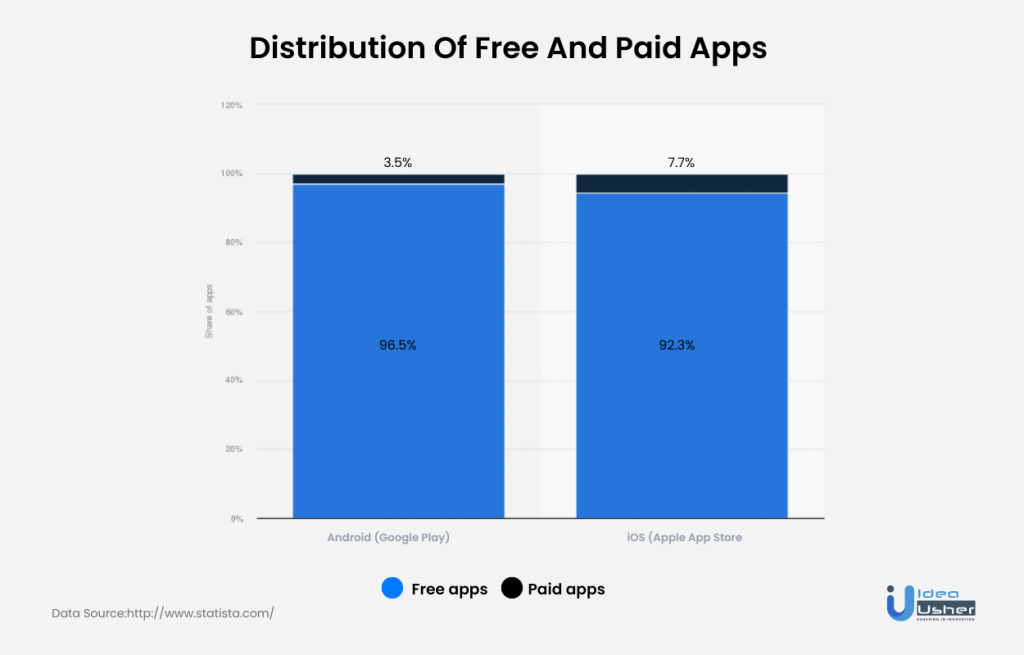
- In March 2023, 97% of apps in the Google Play store were free, with free apps being consistently more popular than paid ones.
- In Q4 2022, global consumer spending on mobile apps totaled nearly $70 billion.
- As of Q3 2022, consumers spent an average of $4.86 on mobile apps per smartphone.
- Apple and Google have faced criticism for their app store commission rates, which were set at 30% as of July 2022.
- In response to this criticism, Apple and Google have changed their app store policies, such as reducing commission fees for smaller publishers and allowing alternative payment methods.
- Microsoft is reportedly preparing to launch a new mobile gaming store to compete with the Apple App Store and Google Play Store.
- Mobile app spending is projected to reach $161 billion on the Apple App Store and $72 billion on Google Play Store by 2026.
Popular Apps Statistics
- In 2022, TikTok surpassed all other mobile apps with a whopping 672 million downloads worldwide.
- Subway Surfers topped the list of most downloaded games in 2022, with a total of 304 million downloads.
- Four of the ten most downloaded apps of 2021 were developed and published by Meta, formerly known as Facebook.
1. Most Popular Apps
In 2022, TikTok maintained its position as the most popularly downloaded app, while its video editing application CapCut was ranked in the top five. Interestingly, Facebook dominated with three apps in the full five downloaded applications list. Source: Apptopia
| App | No. of Downloads in Million (Global) |
| Spotify | 238 |
| Stumble Guys | 254 |
| Subway Surfers | 304 |
| Telegram | 310 |
| Snapchat | 330 |
| CapCut | 357 |
| 424 | |
| 449 | |
| 548 | |
| TikTok | 672 |
In the US, TikTok managed to maintain its status as the most downloaded app for two consecutive years, with an increase in its downloads. Furthermore, Cash App witnessed another rise in popularity in 2022, thereby solidifying its position as the top financial app in the US. Source: Apptopia
| App | No. of Downloads in Million (US) |
| 45.5 | |
| Messenger | 46.3 |
| Amazon | 47 |
| Roblox | 50.9 |
| Subway Surfers | 51.4 |
| Snapchat | 54 |
| 63 | |
| Cash App | 64 |
| 72 | |
| TikTok | 99 |
Google Play Store vs. Apple App Store Statistics In Mobile App Industry
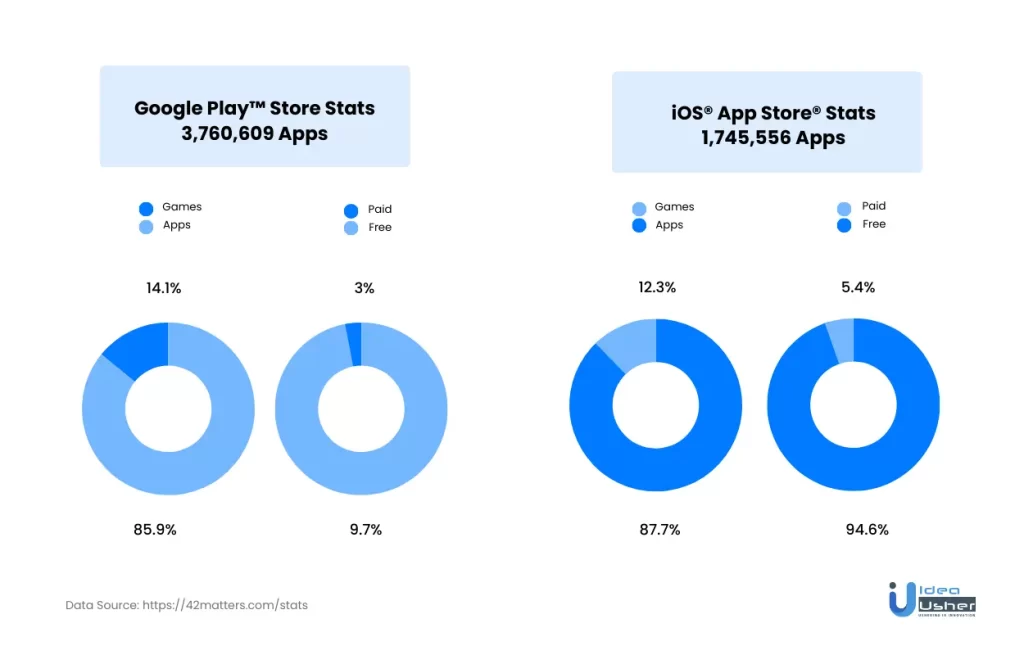
1. Quality (Approval Time):
- The Google Play Store typically takes approximately two hours or less to assess and authorize an app for public use.
- Automated verification procedures are in place to ascertain the absence of malware, viruses, or copyrighted content, and experts also conduct manual checks.
- Conversely, the Apple App Store is more thorough in app reviews before publishing. More than 90% of iOS apps are examined within 48 hours of submission.
- Therefore, it can be inferred that the Apple App Store offers superior-quality apps than Google Play, which has a higher probability of security risks.
2. Revenue:
- Both Google Play Store and Apple App Store share revenue with developers at a 70-30 split in favor of the developer.
- In 2021, the Apple App Store generated $85.1 billion in estimated revenue, while Google Play Store generated nearly $47.9 billion, a 24% increase from the previous year.
- Apple App Store outperforms Google Play in revenue, despite Android holding a 71% mobile and tablet operating system market share worldwide, compared to iOS’s 28.37%.
- As of August 2022, Apple’s market cap is $2.66 trillion, making it the world’s most valuable company.
- As per StatCounter, as of January 2023, Android OS dominates the mobile operating system market with a 71.77% share, although Android’s market share has slightly decreased from around 75%, while iOS’s market share has increased from 23% in 2019 to 27.03% in 2022.
3. Number Of Apps:
- The Apple App Store started with 500 iOS apps and has now grown to include 2.18 million apps as of Q1 2022.
- The Google Play Store is the largest app store, with 3.5 million Android apps as of Q2 2022. In 2021, 111.3 billion mobile apps were downloaded from Google Play worldwide, and it’s projected to increase to 139 billion mobile apps by 2025.
- Google Play Store has a larger number of apps compared to the Apple App Store.
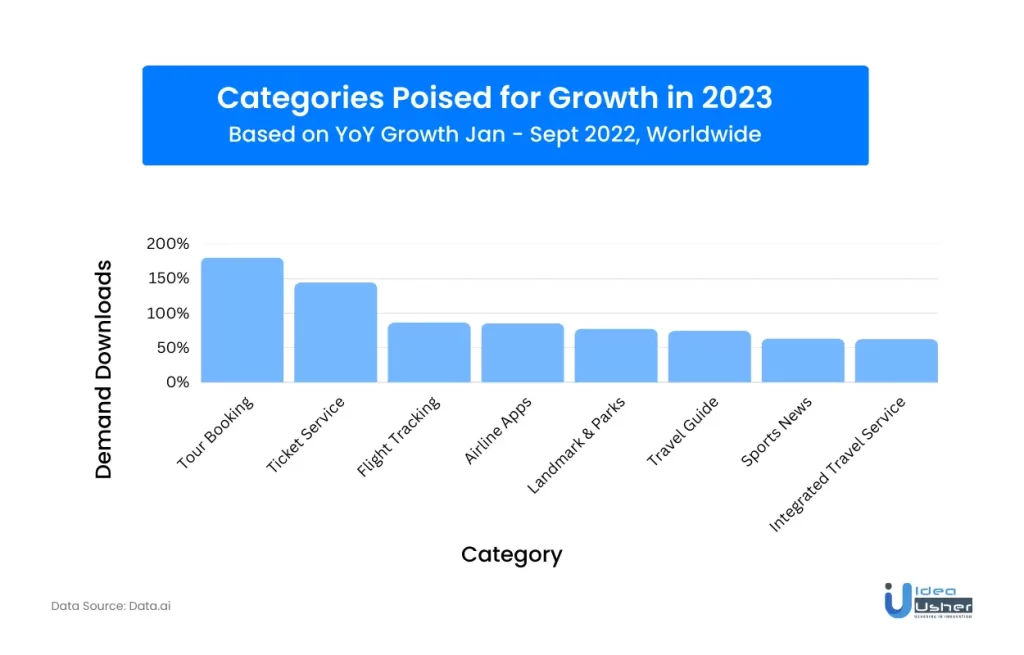
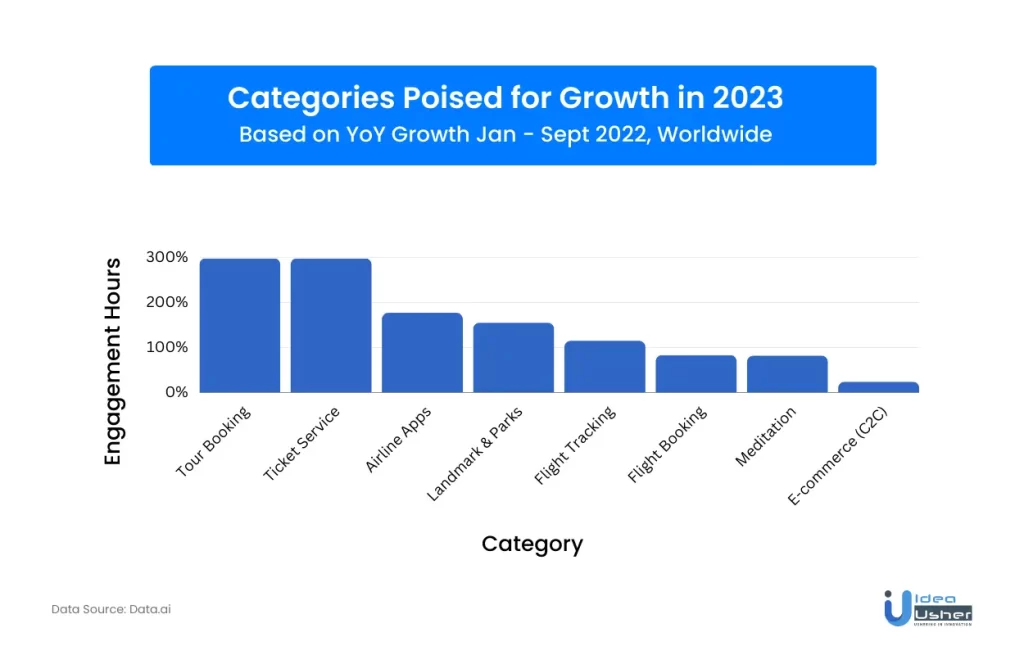
Conclusion
The mobile app industry is expanding at a fast pace, and the trend is expected to continue. As consumers increasingly use their smartphones for various activities, from shopping to entertainment, businesses can take advantage of this trend to reach their target market. In light of advancing technology, the mobile app industry will keep changing, creating new opportunities for companies to improve their business strategies and stay competitive. By adopting the right approach and being informed about industry insights, businesses can leverage the evolving mobile app industry to their advantage. This will enable them to remain ahead of their competitors while providing value to their customers.
Build Better Solutions With Idea Usher
Professionals
Projects
Contact Idea Usher at [email protected]
Or reach out at: (+1)732 962 4560, (+91)859 140 7140
FAQ
Q. How big is the mobile application market?
A. In 2022, the size of the worldwide mobile app market was worth USD 206.85 billion, and experts project it to grow at a compound annual growth rate (CAGR) of 13.8% between 2023 to 2030.
Q. Which companies are major players in the mobile application market?
A. Several prominent companies in the mobile application market are Apple Inc., Google LLC, Microsoft Corporation, Amazon Inc., and Gameloft SE.
Q. What is the mobile application industry?
A. The mobile app industry pertains to a specific area of the software industry that specializes in creating and delivering mobile applications intended for use on mobile devices such as tablets and smartphones. It provides a range of applications spanning various categories, such as gaming, healthcare, fitness, music, entertainment, e-commerce, and retail, among others.
Q. Is the mobile app industry competitive?
A. Regardless of the size and growth of the market, the mobile application industry is highly competitive and challenging. While it may be relatively easy to enter the market, sustaining a successful presentation is a major concern for entrepreneurs.
Q. What are the 6 main categories of apps?
A. Here is the six types of mobile apps:
- Educational app
- Lifestyle apps
- Social media apps
- Productivity apps
- Entertainment apps
- Game apps
Q. What are the Top Mobile App Development Trends in 2025?
A. Here are some of the trends to look for in 2023 and beyond:
- Rise of 5G
- Apps for foldable devices
- AR & VR
- Wearable app integration
- Food & grocery delivery apps
- Mobile entertainment & gaming
- AI & Machine Learning
- Super apps
- Mobile commerce
- P2P mobile apps
- Blockchain
- Predictive analytics
- Mobile learning
- IoT-enabled mobile apps
